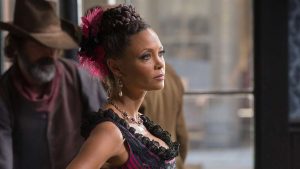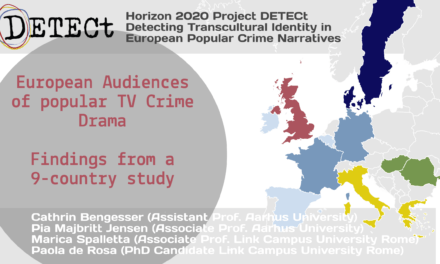The killing of Osama Bin Laden by American special forces may have rid the collective American psyche of a man who at times appeared to be a ghost, but it also raised another ghost. The code name given to Bin Laden by the American government was ‘Geronimo’. Potential insults to the native American community aside, If anyone has any doubts about how the Western still informs the American popular conscious and imagination, then Bin Laden’s assigned nom de guerre should persuade otherwise.
This thought sprung to mind while watching HBO’s latest television offering, Westworld. Although ostensibly, a science fiction programme, based upon the 1973 Crichton film of the same name, Westworld offers, in much the same way as the film, a new and more critical way of exploring the foundational myths of the Western, and its relation to American identity.
In terms of science fiction, Westworld does offer a plenitude of readings, not least in terms of robotics, A.I., Simulacra/Simulation, and dystopian futures (and presents). However, the series’ focus on the Western theme park world (the original film did refer to the other theme park worlds – Roman World and Medieval World), demands a Western-genre reading because the symbolic and representational elements of the Western serve to schematically reveal/critique contemporary culture’s social and emotional preoccupations. This is because contemporary Westerns or ‘Revisionist’ Westerns function as a specific discourse of change or ‘dissonance’, and of imagined, desired, or altered communities. Because the Western is strongly linked to issues of American identity (Coyne 1997), any depiction – intertextual, revisionist, or otherwise – carries with it the potential for ideological analysis. Instances of the Western genre’s ascendency, its demise, or its various attempted revivals at particular moments, have consequently acted less as an indication of the popularity of the form itself, but of the political, or otherwise mind-set of its producers and audiences.
In these last respects, the popularity of the series and the media phenomenon that has surrounded it has offered a seeming volte-face to the general popular cultural belief that Westerns, and TV Westerns especially, have had their day. That they had their day was largely because Westerns became noticeable for those who were excluded or absent from their narratives – namely black and ethnic communities – and also because when included, women and Native Americans in particular, were represented in problematic and ideologically conservative stereotypical ways. Time (and a new series) will tell what role, if any, the native Americans will play in the grand scheme of things, but their presence (or absence) in Westworld has been ethereal. It is an absence that draws attention to how the West in the Western was always a figment of the Anglo-Saxon imagination. Paradoxically, this belief that the Western has had its day has almost certainly been bolstered by Quentin Tarantino’s recent foray into the genre (Django Unchained (2012) and Hateful Eight 2015). Yet Westworld’s Western scenario, although a side-show, has proved popular largely because it exists at a time when the Western needs a hero, but in a form that is palatable to a modern audience. In these respects, placing the Western in the context of a science fiction ‘reverie’ helps partly because we can see it removed from nation-building projects. Whilst Tarantino’s largely iconoclastic re-imaginings draw attention to a genre that no longer speaks to the vast majority of people except through irony; a genre that has left a nation with a vocabulary and a narrative that no longer seems relevant in aspirational terms, Westworld draws attention to the mechanisms of those narratives and the ghost (hosts?) in the machine. In this sense, the Western is used to talk about obsolescence as well as change and dissonance. Again, although the iconography and mythology of the Western still resonates in the American consciousness we can see how in Westworld this resonance functions as a particular discourse, a particular way of speaking to other concerns and issues. Westworld’s thematic preoccupation with narrative building and with creating ‘new’ narratives draws attention to how we experience and understand the world and how particular narratives shape and impact upon that experience and understanding.
That narratives play a huge part in Westworld is without doubt. Not only Does Westworld deal with two types of popular narrative form (Western and Science-Fiction), its marrying of the two provides a means of placing either under the specific gaze of the other. As a consequence, we see technology and science a part of a pioneering, untamed frontier; and American myth, action, and identity placed under forensic and philosophical examination. The outcome leads to conflict through awareness or consciousness – a pseudo Cartesian dualism that symbolically refers to how the west was lost, but also how issues of free-will lay problematically at the heart of the Western and also at the heart of western culture. As Aaron Bady in the New Yorker observes, Westerns are largely about revolts and indirectly, about revolts against slavery or the yoke of civilization and government (2015). The ideas of slavery and of capitalist exploitation of labour, feature prominently in Westworld. Here, Aaron Bady’s attempt to connect the character Ford (Anthony Hopkins) with John Ford, the director of American Western films is understandable but misguided. If the character of Ford in Westworld has any real-life connection, then it is surely with Henry Ford and the capitalist doctrine of Fordism. As Newitzz observes in his study of Capitalist Monsters in American Popular Culture, and in his examination of the ‘Mad Doctor’ character in fiction in particular, the mad doctor “is a monster not because he deviates from professionalism, but because he embodies it.” (2006). Because Ford represents one of the highest class positions in the U.S. economy, he also presents the anxiety that our social fabric, even our reality is being manipulated for corporate-funded concerns, rather than for social and human concerns. For Mead and Applebaum (1975), Westworld’s destruction-restoration sequences “call into question the all too familiar notion that U.S. technology, backed up by seemingly unlimited economic resources, can totally restore or even erase the most violent acts of cruelty, waste, and destruction” in a capitalist system. Yet in Westworld, these ideas they are safely transferred from the realm of the real world to the ‘unreal’ world and existence of the ‘Hosts’ where they play out as part of abstract game. It can be argued that this was always one of the functions of the Western too.
Westworld provides a discursive space for issues around identity and status. The setting of the wild west serves to both indulge its visitors violent fantasies and uncomplicated identity roles, and to highlight the questionable conservative ideology behind these fantasies. The series picks up the agenda of the neo-western film in that it brings into question issues of authenticity. However, in Westworld the ‘authentic’ western experience is not only revealed as a selective history, but is undermined by the inauthentic identities of the hosts. Central to these discursivities is narrative. Narrative is shown as controlling, inauthentic, ambivalent, but also as a means of albeit temporary empowerment. The focus on narrative as a means to control or to possess history of course relates to the agenda of the Western itself. Yet as Maeve (played by the excellent Thandie Newton) observes, this is “some hideous fiction” (S1, Ep 9). Sprinklings of Shakespeare (“These violent delights will have violent ends”, Romeo and Juliet), amongst others, highlight an almost self-reflexive desire and design to remark upon not only the illusionary processes behind the theme park itself, but of the western too. Despite, or perhaps even because of its potentially iconoclastic agenda, the Western scenario in Westworld, points to how its place in the popular imagination is used to offer a set of signs, an iconography, and a language that are used at certain times for certain discourses – as evinced by the Bin Laden episode. This said, the constant juxtaposing with a science fiction narrative also serves to place these discourses under the microscope.

It is in these last respects where the theme park element of Westworld is significant. The theme park scenario not only accents the science fiction element, but also, as Hoberman observes, suggests that this was what the Western always was – a space that not only “offers relief…from the pressures of history…”, but which provided narratives for “the rationalization of aggression” (1991).
We can therefore also consider Westworld-as-theme park in terms of Foucault’s concept of a Heterotopia (1967). Heterotopias are real places or spaces that exists in society, but which usually stand (both physically and symbolically) apart from or outside of society. They usually reflect the ambitions, belief-systems, desires and anxieties of society. Cemeteries, zoos, prisons, and ‘sacred’ spaces are examples of historical heterotopias. One characteristic of heterotopias which Foucault observes is that they separate us from our usual time (“heterochronic”), and more modern heterotopias, such as festivals (or theme parks) are transient. This temporal and transient dynamic always informs Westworld in ways that also informed the Western itself. Here, ghosts of the nation can be laid to rest and as Foucault points out, Heterotopias create an imaginary order and reason which serve to stress their inexistence elsewhere. As Hoberman observes in relation to the Westworld film (1973), Westworld the theme park and the TV series also provides “a new psychological frontier, a jumping-off place for a society that revels in the surface of things, even if deeper problems remain ‘undressed’.” (1991).
Kenneth A Longden has lectured as part of the academic staff at Liverpool John Moores University in Media, Critical, and Creative Arts, and studied for a MPhil/PhD in Transnational Narratives at The University of Winchester. He is a Fellow HEA, and a Peer-Reviewer for various academic journals. He has been published by Intellect Books and Palgrave MacMillan, and writes on Popular Narrative, Film, Television, Fandom, and Popular Culture. He is currently lecturing at Salford University.
Works Cited:
Bady, A. (2016) ‘Westworld, race, and the Western’. The New Yorker, December 9th, 2016
Coyne, M. 1998. The crowded prairie: American national identity in the Hollywood Western. IB Tauris.
Hoberman, J., 1998. How the west was lost. The Western Reader, pp.85-92.
Mead, G. and Applebaum, S., 1975. Fantasy and exploitation. Jump Cut, (7), pp.12-13.





